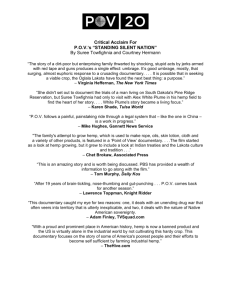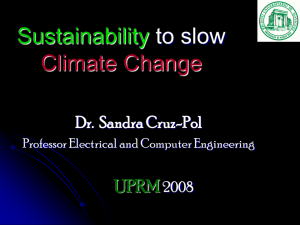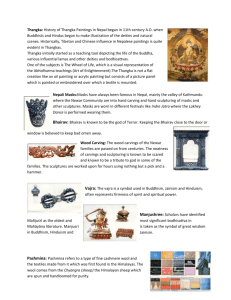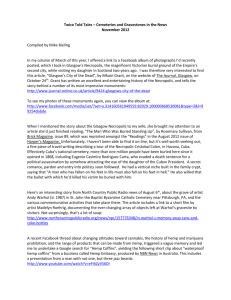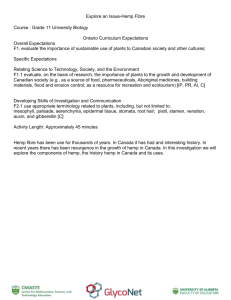Processing of Industrial Hemp into Papermaking Pulps Intended for Bleaching Dariusz Danielewicz,
advertisement
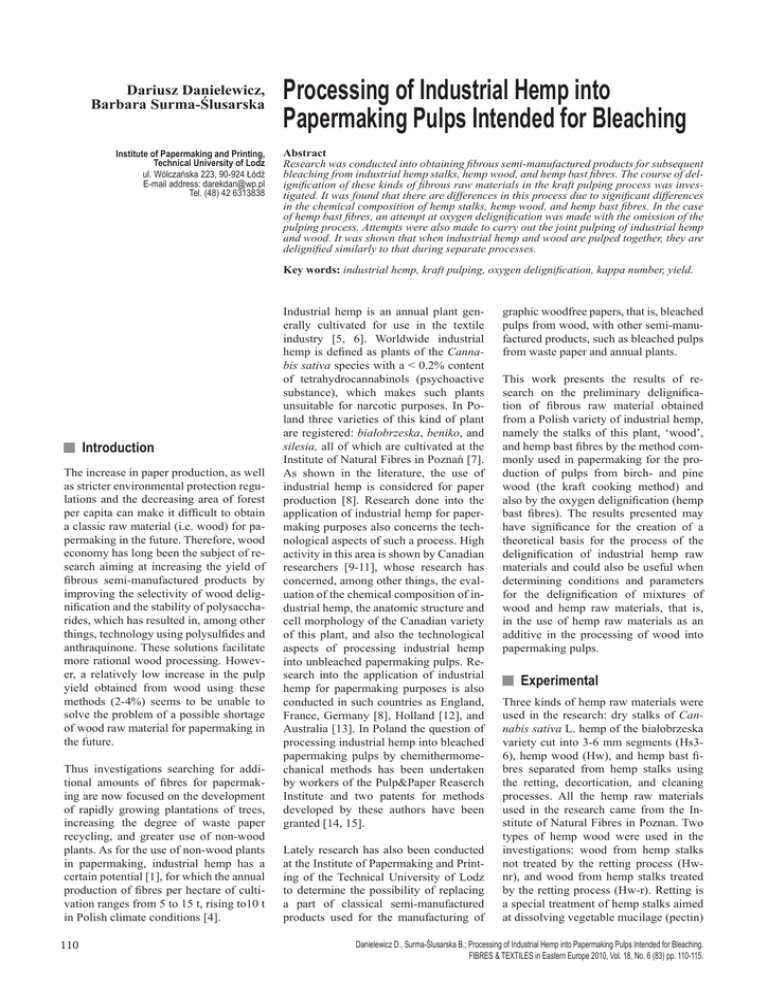
Dariusz Danielewicz, Barbara Surma-Ślusarska Institute of Papermaking and Printing, Technical University of Lodz ul. Wólczańska 223, 90-924 Łódź E-mail address: darekdan@wp.pl Tel. (48) 42 6313838 Processing of Industrial Hemp into Papermaking Pulps Intended for Bleaching Abstract Research was conducted into obtaining fibrous semi-manufactured products for subsequent bleaching from industrial hemp stalks, hemp wood, and hemp bast fibres. The course of delignification of these kinds of fibrous raw materials in the kraft pulping process was investigated. It was found that there are differences in this process due to significant differences in the chemical composition of hemp stalks, hemp wood, and hemp bast fibres. In the case of hemp bast fibres, an attempt at oxygen delignification was made with the omission of the pulping process. Attempts were also made to carry out the joint pulping of industrial hemp and wood. It was shown that when industrial hemp and wood are pulped together, they are delignified similarly to that during separate processes. Key words: industrial hemp, kraft pulping, oxygen delignification, kappa number, yield. Introduction The increase in paper production, as well as stricter environmental protection regulations and the decreasing area of forest per capita can make it difficult to obtain a classic raw material (i.e. wood) for papermaking in the future. Therefore, wood economy has long been the subject of research aiming at increasing the yield of fibrous semi-manufactured products by improving the selectivity of wood delignification and the stability of polysaccharides, which has resulted in, among other things, technology using polysulfides and anthraquinone. These solutions facilitate more rational wood processing. However, a relatively low increase in the pulp yield obtained from wood using these methods (2-4%) seems to be unable to solve the problem of a possible shortage of wood raw material for papermaking in the future. Thus investigations searching for additional amounts of fibres for papermaking are now focused on the development of rapidly growing plantations of trees, increasing the degree of waste paper recycling, and greater use of non-wood plants. As for the use of non-wood plants in papermaking, industrial hemp has a certain potential [1], for which the annual production of fibres per hectare of cultivation ranges from 5 to 15 t, rising to10 t in Polish climate conditions [4]. 110 Industrial hemp is an annual plant generally cultivated for use in the textile industry [5, 6]. Worldwide industrial hemp is defined as plants of the Cannabis sativa species with a < 0.2% content of tetrahydrocannabinols (psychoactive substance), which makes such plants unsuitable for narcotic purposes. In Poland three varieties of this kind of plant are registered: białobrzeska, beniko, and silesia, all of which are cultivated at the Institute of Natural Fibres in Poznań [7]. As shown in the literature, the use of industrial hemp is considered for paper production [8]. Research done into the application of industrial hemp for papermaking purposes also concerns the technological aspects of such a process. High activity in this area is shown by Canadian researchers [9-11], whose research has concerned, among other things, the evaluation of the chemical composition of industrial hemp, the anatomic structure and cell morphology of the Canadian variety of this plant, and also the technological aspects of processing industrial hemp into unbleached papermaking pulps. Research into the application of industrial hemp for papermaking purposes is also conducted in such countries as England, France, Germany [8], Holland [12], and Australia [13]. In Poland the question of processing industrial hemp into bleached papermaking pulps by chemithermomechanical methods has been undertaken by workers of the Pulp&Paper Reaserch Institute and two patents for methods developed by these authors have been granted [14, 15]. Lately research has also been conducted at the Institute of Papermaking and Printing of the Technical University of Lodz to determine the possibility of replacing a part of classical semi-manufactured products used for the manufacturing of graphic wood­free papers, that is, bleached pulps from wood, with other semi-manufactured products, such as bleached pulps from waste paper and annual plants. This work presents the results of research on the preliminary delignification of fibrous raw material obtained from a Polish variety of industrial hemp, namely the stalks of this plant, ‘wood’, and hemp bast fibres by the method commonly used in papermaking for the production of pulps from birch- and pine wood (the kraft cooking method) and also by the oxygen delignification (hemp bast fibres). The results presented may have significance for the creation of a theoretical basis for the process of the delignification of industrial hemp raw materials and could also be useful when determining conditions and parameters for the delignification of mixtures of wood and hemp raw materials, that is, in the use of hemp raw materials as an additive in the processing of wood into papermaking pulps. Experimental Three kinds of hemp raw materials were used in the research: dry stalks of Cannabis sativa L. hemp of the białobrzeska variety cut into 3-6 mm segments (Hs36), hemp wood (Hw), and hemp bast fibres separated from hemp stalks using the retting, decortication, and cleaning processes. All the hemp raw materials used in the research came from the Institute of Natural Fibres in Poznan. Two types of hemp wood were used in the investigations: wood from hemp stalks not treated by the retting process (Hwnr), and wood from hemp stalks treated by the retting process (Hw-r). Retting is a special treatment of hemp stalks aimed at dissolving vegetable mucilage (pectin) Danielewicz D., Surma-Ślusarska B.; Processing of Industrial Hemp into Papermaking Pulps Intended for Bleaching. FIBRES & TEXTILES in Eastern Europe 2010, Vol. 18, No. 6 (83) pp. 110-115. to facilitate the separation of bast fibres from one another and from wood. As for the hemp bast fibres, the kappa number of these fibres was 20.4. They were cut into approximately 3 mm segments using a paper cutter before being processed and marked as Hbf3. All the hemp raw materials used in the research are presented in Figure 1. The second kind of raw material used in the investigations was birch wood (Betula verucosa) and pine wood (Pinus silvestris) in the form of industrial chips. Cut hemp stalks (Hs3-6) Hemp wood (Hw-nr) Hemp wood (Hw-r) Uncut and cut hemp bast fibres (Hbf3) Pulping process The pulping of the hemp raw materials and birch- and pine wood chips was carried out in a Santasalo-Sohlberg rotary digester with 300 mL autoclaves. The birch- and pine chips were screened, and the fractions which passed f 23 mm was retained on the 13 mm openings of the sieves of the laboratory sorting machine used, after being additionally sorted by hand to remove knots and bark. The active alkali charges were within the range 4-26% (on o.d. fibres or wood), respectively. For cooking, the sulfidity of the pulping liquor was 25%. The liquor-towood ratio was 5:1 for hemp stalks and hemp wood and 6:1 for hemp bast fibres. In all the cooking tests the temperature was raised to 165°C in 90 min and held at 165°C for 90 min. After cooking, the chips were washed first on wire mesh and then by diffusion with deionised water for 24 h and finally disintegrated. The pulp was then centrifuged and, after its dryness had been determined, stored in closed polyethylene bags under wet conditions in a refrigerator. The results for the pulping process of birch- and pine wood presented in Figures 2, 3 & 6, were obtained from research performed within the framework of our other investigation. In this work, experiments on the common pulping of birch- or pine wood with hemp stalks were also performed, the results of which are presented in Figures 6 & 7. The time, temperature and liquid-to-wood ratios in these experiments were the same as in the case of the delignification process of birch- and pine wood. The amounts of active alkali used in the experiments, the results of which are presented in Figure 7, in which birch- and FIBRES & TEXTILES in Eastern Europe 2010, Vol. 18, No. 6 (83) Figure 1. Fibrous raw materials used in the research. pine wood were used, were 19 and 23% for oven-dried wood, respectively. Oxygen delignification Only hemp bast fibres delignified with oxygen in alkaline media were considered in this work. A Jayme reactor was used to delignify pulps using this method. In all the experiments, the amount of hemp bast fibres used in the oxygen delignification stage (oven-dry basis) was 40 g. The experiments were carried out at a consistency of 8% and oxygen pressure of 0.6 MPa at 100 °C. At the beginning of each experiment, a 0.1% charge (on oven-dried pulp) of MgSO4 was first dissolved in an amount of water, mixed with the pulp, and then an NaOH charge (on oven-dried fibres) was added together with the rest of the water. The pulp was mixed with chemicals, placed in the reactor, and oxygen pressure was applied. After 60 min of delignification, the pressure was released, the reactor opened, and the pulp was discharged, filtered, washed with four portions of 1000 ml deionised water and put in a new plastic bag for further treatment. Analytical Cellulose, lignin, ash, and the extractive contents in the wood were determined according to PN-92/P-50092 (‘Wood. Chemical analysis’). In this standard, cellulose is obtained according to the method described by Seifert [16], while the attainment of acid insoluble lignin, ash, and extractives is undertaken according to Tappi Standards T 222 om-83, T 211 om-85, and T 280 pt-99, respectively. The Kappa number of the pulps was determined according to the standard method PN-85/P-50095/02 (eqv. ISO 302-1981). Results and discussion The main goal of the pulping process of fibrous raw materials is to obtain a semi-manufactured product characterised by a low reject content and content of residual lignin required for further processes, namely oxygen delignification and bleaching, Such properties of pulps are usually obtained at a residual lignin content corresponding to a Kappa number of 20-30. In the first part of our research, the susceptibility of industrial hemp to delignification with kraft cooking liquor containing NaOH and Na2S dissolved in water was investigated and the results compared with the susceptibility of birch- and pine wood to delignification with the same liquor. As mentioned in the experimental section, the following raw materials were used in the investigations: hemp stalks cut into 3-6 mm long pieces (Hs3-6), hemp wood obtained from hemp stalks not subjected- and subjected to the retting process (Hw-nr and Hw-r, respectively), and hemp bast fibres obtained 111 from hemp stalks subjected to retting (Hbf3) (Figure 1). The results of investigations of the susceptibility of these raw materials to delignification with kraft liquor are shown in Figure 2 (see page 106). All pulping operations were carried out under the same conditions (time, temperature); the variable parameters were the amount of active alkali added and the liquid-to-wood ratio The data presented in Figure 2 indicate that in order to obtain a pulp with a Kappa number of 20-30 from hemp stalks (Hs3-6), it is necessary to use 14.5-15.5% active alkali in relation to an oven-dried mass of raw material in the kraft pulping process. Thus, the susceptibility of this raw material to delignification with kraft liquor is better than that of birch wood and much better than that of pine wood. The susceptibility of hemp wood to delignification using kraft liquor was determined as well. As shown in Figure 2, both raw materials required more active alkali than hemp stalks (Hs3-6) to reach a Kappa number of 25-30. Figure 2 also shows that the susceptibility to pulping of hemp wood obtained from hemp stalks not subjected to retting (Hw-nr) was comparable to that of birch wood, while that obtained from hemp stalks treated by retting (Hw-r) was much worse than that of birch wood and comparable to that of pine wood. This indicates that the retting process has a negative effect on the susceptibility of hemp wood to delignification with kraft cooking liquor. 100 90 Kappa number 80 70 Hs 3-6 As regards yield, pulp from the inner parts of hemp stalks, that is, hemp wood, gives worse results in comparison with pulp from industrial hemp stalks. It can be stated that the yield at a Kappa number of 25 is 5-9% lower in comparison with that of birch pulp. According to Figure 3, this difference is smaller in the case of pulp from hemp wood obtained from hemp stalks not subjected to the retting process (nr), which also indicates that as far as the yield processing of such hemp wood is concerned, this gives better results than the processing of hemp wood from stalks subjected to retting (Hw-r). From among all the raw materials used in the investigations, pulp from industrial hemp bast (Hbf3) is characterised by the highest yield. As already mentioned, this raw material is characterised by a Kappa number of 20.4 in the initial condition. However, Figure 3 shows that the treatment of hemp bast with kraft cooking liquor, even with a small amount of ac- 80 Hw-nr Hw-r 76 Hbf3 72 B 50 40 30 Hw-r Hbf3 B P 60 56 52 48 10 44 Figure 2. Relationship between the Kappa number and the amount of active alkali added in the process of the delignification of hemp raw materials and birch and pine wood. Hw-nr 64 20 0 2 4 6 8 10 12 14 16 18 20 22 24 26 28 Hs 3-6 68 P Amount of added active alkali, % o.d.raw-m aterial 112 The data presented in Figure 3 show that pulp from hemp stalks (Hs3-6) at a Kappa number of 20 is characterised by a 5% higher yield than that from birch wood, and at a Kappa number of 30 – by an approximately 14% higher yield than that from pine wood. The yield of semi-manufactured products from a unit weight of raw material is a very important factor defining the profitable of processing a given raw material into bleached pulp. Figure 3 shows values of this index for pulps in the pulping process of hemp raw materials and wood 60 0 for comparison. These results were compared to those for the yield of pulps from birch- and pine wood in a typical range of Kappa numbers for hardwood and softwood pulps intended for bleaching, that is, 20-30. Figure 2 shows that even when using 14% active alkali in relation to ovendried fibres it was possible to decrease the Kappa number only to a level of 8 units. The curve of bast fibre delignification shows that these fibres are hard to delignify with kraft cooking liquor, and its inclination angle suggests that the course of Kappa number variations from the very beginning of the delignification corresponds to the so-called residual delignification stage encountered in the process of wood delignification, which distinguishes the course of the delignification of hemp bast fibres from that of the delignification of the remaining raw materials used in the research, in which the phase of residual delignification appears in the final phase of delignification (Figure 2). Yield of pulo, % 110 Hemp bast fibres separated from stalks proved to constitute a special case. These fibres are characterised by a Kappa number of 20.4 in the initial condition, which would indicate the possibility of processing them into bleached pulps by oxygen delignification and bleaching with the omission of the pulping process. However, in this study, a series of experiments on the kraft pulping of bast fibres was conducted as well. 40 0 10 20 30 40 50 60 70 80 90 Kappa number Figure 3. Comparison of pulp yields from industrial hemp raw materials and conventional ones from wood at their different pulping levels. FIBRES & TEXTILES in Eastern Europe 2010, Vol. 18, No. 6 (83) tive alkali (e.g. 4% in relation to the bast fibre weight), results in a decrease in pulp yield to approximately 73-74%, suggesting that at high temperature and under the influence of the components of kraft liquor, the considerable amount of carbohydrates contained in hemp bast fibres dissolves. Differences in the susceptibility to pulping and in the yields of pulps from a unit weight of the raw materials investigated may result from the content of their chemical components; above all, cellulose and lignin. The results of such determinations are presented in Table 1. The data in Table 1 show that hemp stalks are characterised by a higher content of cellulose, determined by the Seifert method, in comparison with both birchand pine wood, which mainly results from the high content of this component (71.7%) in the bast part of the plant and not in the woody part, because in the latter the content of cellulose is at the less beneficial level of approximately 36%, demonstrating that the content of cellulose in the woody part of hemp stalks is relatively low. A similar content of cellulose in hemp wood of the Canadian variety of industrial hemp (33.4%) was obtained by Canadian authors [11]. The content of cellulose affects the yield of pulp from the raw material, while the lignin content is essential mainly from the point of view of the evaluation of the susceptibility of a given raw material to pulping. As the data in Table 1 show, a Ash Hemicelluloses and pectins2) 1.1 1.3 32.5 27.1 1.2 1.2 34.3 71.7 4.0 0.9 1.5 21.9 Birch wood1) 42.6 20.4 2.8 0.3 33.9 Pine wood1 45.5 28.5 1.6 0.4 24.0 Cellulose Lignin Extractives Hemp stalks 46.9 18.2 Hemp wood 36.3 Hemp bast fibres Raw material % Results obtained from our research performed within the framework of our other research Constituent content calculated by subtracting the sum of the cellulose, lignin, extractives, and ash contents from 100%. 1) 2) lower content of lignin (4%) was found in hemp bast fibres. In turn, in the case of hemp wood, it was ca. 27%, which was close to the content of lignin in pine wood. The content of this constituent in hemp stalks was approximately 18%, which explains the better susceptibility of hemp stalks to kraft pulping in comparison with birch and pine wood, as stated above. The content of extractives and mineral substances in the raw materials investigated was determined as well. The data in Table 1 show that the content of substances extracted by acetone in hemp raw materials was at a lower level than in the case of birch- and pine wood. Apart from cellulose, lignin, extractives, and inorganic substances, industrial hemp also contains a certain amount of lower polymerised carbohydrates than that of cellulose, that is, hemicelluloses and pectins. In this work their content was calculated by subtracting the sum of 22 100 20 95 18 the contents of cellulose, lignin, extractives, and ash from 100%. As the data in Table 1 show, the content of these substances in hemp stalks and hemp wood is approximately the same as that in birch wood (32.5-34.3%), while in hemp bast fibres it is considerably lower (ca. 22%). The fibrous form and low initial Kappa number of hemp bast fibres (20.4) as well as the low yield of pulp from these fibres in the process of kraft pulping (Figure 3) encouraged the authors to investigate the possibility of obtaining pulps of the pulping degree required prior to bleaching the raw material by treating it with oxygen in an alkaline environment, that is, without the kraft pulping process. The aim was to decrease the content of lignin in hemp bast fibres to a level corresponding to a Kappa number of 10-12. The results of these investigations are presented in Figure 4. As Figure 4 shows, hemp bast fibres are delignified with oxygen very well. Pulp Hbf3 (Oxygen delignification) 90 Hbf3 16 85 Yield, % Kappa number Table 1. Chemical characteristics of the raw materials used in the research 14 12 75 10 70 8 65 6 Hbf3 (Kraft pulping) 80 60 0 0.2 0.4 0.6 0.8 1 1.2 1.4 1.6 1.8 2 Amount of metered NaOH, % o.d.fibres Figure 4. Variations in the Kappa number of hemp bast fibres in the oxygen delignification process depending on the amount of NaOH used. FIBRES & TEXTILES in Eastern Europe 2010, Vol. 18, No. 6 (83) 6 10 14 18 22 Kappa number Figure 5. Yield of hemp bast fibres in the process of their oxygen delignification compared with that in the process of delignification with kraft cooking liquor. 113 An important argument for selecting oxygen delignification as a process in which pulp from hemp bast fibres is prepared for bleaching could be their higher yield in comparison with that in the process of their delignification with kraft liquor. Figure 5 (see page 113) shows changes in this index as a function of the Kappa number. At the level of lignin content defined by a Kappa number of 10, as shown in Figure 5, the yield of pulp from bast fibres amounts to 89%, which is approximately 24% more than in the case of the kraft pulping process. Oxygen delignification is thus a more favourable method of delignifying hemp bast fibres in order to prepare them for bleaching than the kraft pulping process. Further work concerned the joint pulping of wood and hemp stalks (Hs3-6) using the kraft pulping method. In industry the simplest method of using raw materials in the form of cut hemp stalks seems to be processing them together with wood chips. Pulping tests were carried out in the autoclaves of a Santasalo-Sohlberg digester in which wood and non-wood raw materials were separated from each other with net baffles. It was assumed that the content of the autoclaves would be, by weight, 80% wood chips (pine or birch) and 20% hemp stalks. 100 90 80 Kappa number 70 60 50 In the first part of these investigations, the authors determined the effect of joint pulping birch- and pine wood chips with hemp stalks Kappa number of pulps from the individual raw materials and compared it with the Kappa number of raw materials obtained in the process of separate cooking (Figure 6). Denotations B(+Hs3-6) and P(+Hs3-6) indicate the Kappa numbers of birch- and pine pulp obtained in the joint pulping of birch- or pine wood chips, respectively, with hemp stalks, while Hs3-6(+B) and Hs3-6(+P) indicate the Kappa numbers of hemp stalk pulp obtained from the common cooking of hemp stalks with birch- or pine wood chips, respectively. The bro�ken lines mark the Kappa numbers of the individual raw materials obtained during separate pulping. Analysis of these results allows to state that the joint pulping of wood and cut hemp stalks (Hs3-6) results in a pulping degree that is approximately similar to that obtained during separate pulping. Figure 6 shows that the curves illustrating the interrelation of the Kappa number and amount of active alkali used for pine wood (P) and birch wood (B) in pulping are almost identical to those illustrating the joint pulping of these raw materials with hemp stalks, marked as B(+Hs3-6) and P(+Hs3-6). Figure 6 also shows that the Kappa number of industrial hemp pulped together with wood is between 15 and 20 units, which is slightly higher than in the case of the separate pulping of this raw ma- P (+Hs 3-6) Hs 3-6 (+P) 40 30 114 Industrial hemp raw materials, that is, hemp stalks, hemp wood, and hemp bast fibres could be processed into papermaking pulps suitable for bleaching by the methods used in conventional papermaking raw materials i.e. the wood of trees. In the case of hemp stalks and hemp wood, delignification should begin with pulping, in which a similar time and temperature conditions and smaller (hemp stalks) or comperable (hemp wood) amount of alkali are used than for birch- and pine wood, while in the case of hemp bast fibres, due to the low content of lignin in 100% B 80% B + 20% Hs 3-6 100% P 52 100% P + 20% Hs 3-6 50 48 46 44 10 42 Figure 6. Kappa numbers of pulps obtained in the process of joint pulping wood and hemp stalks. Conclusions 54 20 0 14 15 16 17 18 19 20 21 22 23 24 25 26 27 28 Amount of added active alkali, % o.d.raw-m aterial Figure 7 shows that the average increases in the pulp yield in the process of the common pulping of birch- or pine wood with hemp stalks (with the share of hemp stalks being 20%) were 2.9 and 2.5%, respectively, in comparison to the pulp yield in the process of pulping clean wood. 56 P Hs 3-6 (+B) The pulp yields obtained from the common pulping of birch- or pine wood with hemp stalks were also determined. These results are presented in Figure 7. In this Figure the points Figure at which the numbers are written represent the average values of yields obtained from triplicate pulping experiments. 58 B (+Hs 3-6) Hs 3-6 terial. Owing to this, the difference between the Kappa number of hemp and birch pulps and that of hemp- and pine pulps decreases. At Kappa numbers of 20 and 30, it amounts to approximately 5 and 15 units, respectively. 60 B Yields of pulps, % from such fibres with a Kappa number of 10-12 can already be obtained after using 0.9-1.4% NaOH in relation to the mass of oven-dried fibres. 40 15 19 23 27 31 35 39 Kappa number Figure 7. Comparison of the yields of pulps in the process of pulping birch wood, pine wood and mixtures of birch- and pine wood with hemp stalks. FIBRES & TEXTILES in Eastern Europe 2010, Vol. 18, No. 6 (83) this raw material, it can begin with oxygen delignification. The wood layer of hemp stalks contains approximately 36% cellulose and 27% lignin by weight, while hemp bast contains approximately 72% cellulose and only 4% lignin. As a result, the content of the components mentioned above in whole hemp stems takes intermediate values, that is, approximately 47% cellulose and 18% lignin, thus being more favourable than in the case of birch- and pine wood. The differences in the chemical compositions of wood and hemp bast have a considerable effect on the susceptibility to delignification of hemp raw materials and on the yield of pulp from a mass unit. Hemp bast is the most easily delignified, with the highest yield, followed by stalks, while it is the most difficult to delignify the wood of hemp stalks. Taking into consideration the application of hemp raw materials in papermaking, it seems that hemp stalks are the most advisable. The yield of hemp stalks in the kraft pulping process at a Kappa number of 20 is characterised by an approximately 5% higher yield in comparison to birch pulp, and at a Kappa number of 30 – by an approximately 14% higher yield than pine pulp. The joint pulping of wood and industrial hemp stalks results in such pulping degree of raw materials, which is obtained during a separate pulping process. Hemp pulps obtained in joint kraft pulping with wood at Kappa numbers of 20 or 30 are thus pulped to a higher degree. The difference in the Kappa number between these pulps and those from wood amounts to approximately 5 to 15 Kappa number units. The average increase in pulp yield in the process of the common kraft pulping of birch- or pine wood chips with hemp stalks (with the share of hemp stalks being 20%) was 2.9 and 2.5%, respectively in comparison with the pulp yield in the process of pulping clean birch- and pine wood. Acknowledgements The research was financially supported by the Polish Ministry of Science and Higher Education in the years 2008–2010 as a part of Research Project No. N N508 380135. FIBRES & TEXTILES in Eastern Europe 2010, Vol. 18, No. 6 (83) References 1.Kane M.: ‘Getting a problem fiber? Hemp is at hand’, PPI, 42, 4, 2000, 33-35. 2. Fisher S.: ‘Hanf-Zellstoff – Rohstoff fur die Papierindustrie’, Wochenblatt fur die Papierfabrikation, 123, 19, 1995, 878. 3. Leponiemi A.: ‘Non-wood pulping possibilities – a challenge for the chemical pulping industry’, Appita J., 61, 3, 2008, 235. 4. Kozłowski R., Mańkowski J., Kubacki A., Kołodziej J.: ‘Efektywna technologia produkcji dekortykowanego włókna konopnego, alternatywnego surowca dla przemysłu celulozowo-papierniczego’, Materiały XV Międzynarodowej Konferencji Papierniczej PROGRESS,05, 28-30.09.2005 Wrocław (in Polish). 5. Sadelnik N.: ‘Properties of hemp fibre cottonised by biological modification of hemp hackling noils’, Fibres Text. East. Eur., 12, 1, 2004, 58-60. 6. Cierpucha W., Kozłowski R., Mańkowski J., Waśko J., Makowski T.: ‘Applicability of flax and hemp as a raw materials for production of cotton-like fibres and blended yarns in Poland’, Fibres Text. East. Eur., 12, 3, 2004, 13-18. 7. Grabowska L.: ‘Polish varieties of fibrous hemp present in COBOR register (in Polish)’, Flex and hemp Nr 1 (2004). 8. Johnson P.: ‘Industrial hemp: A critical review of claimed potentials for Cannabis sativa’, Tappi J., 82, 7, 1999, 113-123. 9. Correia F., Roy D.N., Goel K. ‘Pulping of Canadian industrial hemp (Cannabis Sativa L.)’, Pulp Paper Can., 99, 9, 1998, 39-41. 10. Correia F., Roy D.N., Chute W.: ‘Hemp chemical pulp: A reinforcing fibre for hardwood kraft pulps’ Pulp Paper Can., 104, 5, 2003, 51-54. 11. Correia F., Roy D.N., Goel K.: ‘Chemistry and delignification kinetics of Canadian industrial hemp (Cannabis sativa L.), JWCT, 21, 2, 2001, 97-111. 12. De Groot B., Van der Kolk J.C., Van Dam J.E.G, Van T’ Riet K.: ‘Papermaking characteristics of alkaline hempwoody-core pulps’, Tappi J., 82, 7, 1999, 107-112. 13. Lisson S.N.: ‘Studies of fibre hemp and flex pulps as a feedstock for Australian newsprint production’. Appita J., 54, 5, 2001, 449-456. 14. Stupińska H. i inni: ‘Sposób wytwarzania papierniczej masy bielonej z łodyg roślin łykodajnych’, Patent PL 198456 (2008). 15. Stupińska H. i inni: ‘Sposób wytwarzania długowłóknistej bielonej masy celulozowej z włókna roślin łykodajnych’, Patent PL 197602 (2008). 16. Seifert, K. ‘Zur Frage der CelluloseSchnellbestimmung nach der Acetylacetone-Methode’. Das Papier, 10, 7, 1956, 301. UNIVERSITY OF BIELSKO-BIAŁA FacultyofTextileEngineering andEnvironmentalProtection The Faculty was founded in 1969 as the Faculty of Textile Engineering of the Technical University of Łódź, Branch in Bielsko-Biała. It offers several courses for a Bachelor of Science degree and a Master of Science degree in the field of Textile Engineering and Environmental Engineering and Protection. The Faculty considers modern trends in science and technology as well as the current needs of regional and national industries. At present, the Faculty consists of: The Institute of Textile Engineering and Polymer Materials, divided into the following Departments: Polymer Materials Physics and Structural Research Textile Engineering and Commodity Textile Engineering and Commodity Applied Informatics The Institute of Engineering and Environmental Protection, divided into the following Departments: Biology and Environmental Chemistry Hydrology and Water Engineering Ecology and Applied Microbiology Sustainable Development Processes and Environmental Technology Air Pollution Control University of Bielsko-Biała Faculty of Textile Engineering and Environmental Protection ul. Willowa 2, 43-309 Bielsko-Biała tel. +48 33 8279 114, fax. +48 33 8279 100 E-mail: itimp@ath.bielsko.pl Received 6.01.2010 Reviewed 1.10.2010 115
